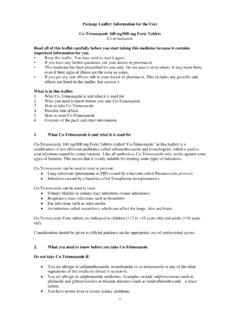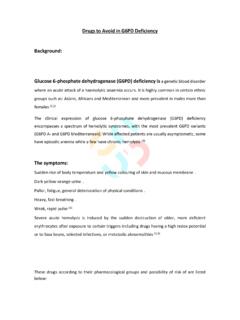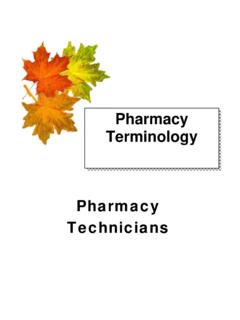Transcription of Intravenous to Oral Conversion for Antimicrobials
1 Clinical Practice Standard 1-20-6-1-010. TITLE: Intravenous TO ORAL Conversion FOR. Antimicrobials . A printed copy of this document may not reflect the current, electronic version on OurNH. APPLICABILITY: All sites and facilities RELATED 1-20-6-4-090: Medication Adaptation POLICIES: DEFINITIONS: Antimicrobial: An antibiotic, antifungal or antiviral;. Bioavailability: amount of drug absorbed into the body; Potency: combination of bioavailability plus amount of actual body exposure to drug after administration of 1 dose (area under the curve =. AUC). COMPETENCY. REQUIREMENTS: KEY POINTS. Timely Conversion from Intravenous (IV) to oral (PO) antimicrobial therapy is effective for a variety of infections, especially for agents with excellent bioavailability.
2 Conversion from IV to PO Antimicrobials in select patients results in cost savings for the facility as well as aim for positive clinical outcomes such as shortened hospital stay, reduced risk of line-related infections and adverse events and no IV. related mobility restrictions for patients. POLICY STATEMENT (ALL STAFF MUST COMPLY). All patients initiated on IV Antimicrobials will be assessed for Conversion to oral antibiotics. Oral Antimicrobials will be used preferentially whenever appropriate for the clinical circumstances of the patient. CLINICAL PRACTICE STANDARD (ALWAYS USE PROFESSIONAL JUDGMENT AND. DOCUMENT ANY DEVIATION FROM THE STANDARD). Consider a change in route of administration of antimicrobial drug therapy when the following circumstances apply: 1.
3 Improving clinically Author(s): Antimicrobial Stewardship Program Coordinator Page 1 of 6. Issuing Authority: Vice President Medicine and Clinical Programs; Regional Director, Pharmacy Services Date Issued (I), REVISED (R), reviewed (r): November 13, 2015 (I); October 28, 2016 (r); April 24, 2018 (R). This material has been prepared solely for use at Northern Health (NH). NH accepts no responsibility for use of this material by any person or organization not associated with NH. No part of this document may be reproduced in any form for publication without permission of NH. A printed copy of this document may not reflect the current, electronic version on OurNH.
4 Intravenous to Oral Conversion for Antimicrobials 1-20-6-1-010. Consistent improvement in fever over the last 24 hours or patient is afebrile (less than 38 C), and White blood cells decreasing, and Hemodynamically stable 2. Able to tolerate and absorb oral medications Tolerating enteral feeds or eating/drinking fluid diet; taking other medications orally No severe or persistent nausea, vomiting or diarrhea No gastrointestinal obstruction, ileus, malabsorption syndrome, active gastrointestinal (GI) bleed or continuous gastric suctioning if orogastric/nasogastric (N/G). 3. Pathogen is not known to be resistant to the oral antimicrobial to be used 4. Patient does not have any of the following exclusion criteria: Patient is less than or equal to 18 years of age (paediatric patients).
5 Nothing by mouth (NPO) status with no medications being given orally Continuous feeds that cannot be held if antimicrobial agent known to bind to enteral nutrition formulation Difficulty swallowing or loss of consciousness and no orogastric/N/G available Short Gut syndrome Acute treatment phase of listed conditions (discuss with infectious disease physician involved). o Febrile neutropenia o Bacteremia with staphylococcus aureus or Enterococcus species o Severe sepsis o CNS infection ( , meningitis, encephalitis). o Endophthalmitis o Endocarditis o Osteomyelitis/discitis o Vertebral or deep abscesses o Bone and joint infections o Septic arthritis Author(s): Antimicrobial Stewardship Program Coordinator Page 2 of 6.
6 Issuing Authority: Vice President Medicine and Clinical Programs; Regional Director, Pharmacy Services Date Issued (I), REVISED (R), reviewed (r): November 13, 2015 (I); October 28, 2016 (r); April 24, 2018 (R). This material has been prepared solely for use at Northern Health (NH). NH accepts no responsibility for use of this material by any person or organization not associated with NH. No part of this document may be reproduced in any form for publication without permission of NH. A printed copy of this document may not reflect the current, electronic version on OurNH. Intravenous to Oral Conversion for Antimicrobials 1-20-6-1-010. IV to PO Conversion Regimen Recommendations Oral Antimicrobials equally potent to the IV formulation Parenteral Therapy Oral Therapy Oral Bioavailability Ciprofloxacin 200 mg IV q12h Ciprofloxacin 250 mg PO BID 70%.
7 Ciprofloxacin 400 mg IV q12h Ciprofloxacin 500 to 750 mg PO. BID. NOTE: space oral dose two hours before or six hours after calcium, magnesium and iron. Hold enteral feeds one hour before and after dose (do not use oral suspension in feeding tubes due to clogging). Clindamycin 600 mg IV q8h Clindamycin 450 mg PO TID 90%. Fluconazole IV once daily (daily Fluconazole po once daily (daily 90%. dose same for both IV and PO dose same for both IV and PO. administration) administration). Levofloxacin 750 mg IV q24h Levofloxacin 750 mg PO daily 99%. Levofloxacin 500 mg IV q24h Levofloxacin 500 mg PO daily Metronidazole 500 mg IV q8h Metronidazole 500 mg PO TID 100%.
8 Metronidazole 500 mg IV q12h Metronidazole 500 mg PO BID. Moxifloxacin 400 mg IV once Moxifloxacin 400 mg PO once 90%. daily daily sulfamethoxazole trimethoprim sulfamethoxazole trimethoprim 85%. (co- trimoxazole ) 800/160 mg IV (co- trimoxazole ) 1 DS tab PO. q8h BID. Voriconazole 400 mg IV q12h x Voriconazole 400 mg PO BID x 2 96%. 2 doses then 200 mg IV q12h doses then 200 mg PO BID. NOTE: Adjust the above doses for the indication, patient's age, weight, and renal function when necessary. Oral Antimicrobials less potent than IV formulation. Step-down to a less potent oral agent requires individual patient assessment Parenteral Therapy Oral Therapy** Oral Bioavailability Azithromycin 500 mg IV Azithromycin 500 mg PO x 1 then 250 37%*.
9 Once daily x 3 days (5 days mg PO once daily x 4 days if suspected legionella) Or Azithromycin 500 mg PO daily x 3 days Author(s): Antimicrobial Stewardship Program Coordinator Page 3 of 6. Issuing Authority: Vice President Medicine and Clinical Programs; Regional Director, Pharmacy Services Date Issued (I), REVISED (R), reviewed (r): November 13, 2015 (I); October 28, 2016 (r); April 24, 2018 (R). This material has been prepared solely for use at Northern Health (NH). NH accepts no responsibility for use of this material by any person or organization not associated with NH. No part of this document may be reproduced in any form for publication without permission of NH.
10 A printed copy of this document may not reflect the current, electronic version on OurNH. Intravenous to Oral Conversion for Antimicrobials 1-20-6-1-010. Cefazolin 1 g IV q8h Cephalexin** 500 mg PO QID 90%. Cefuroxime 750 mg IV q8h Cefuroxime 500 mg PO BID with food 50%. Cefuroxime g IV q8h Cloxacillin 1 to 2 g IV q6h Cloxacillin 500 mg PO QID one hour 50%. before or two hours after meals or Cephalexin 500mg po QID. Penicillin G 1 to 2 million Penicillin V 300 mg PO QID 60-73%. units IV q6h or Amoxicillin 500 mg PO TID Amoxi = 80%. Acyclovir# 5mg/kg IV q8h Acyclovir# 400 mg PO TID Acyclovir = 10. or Valacyclovir# 1 g po BID 20%. Valacyclovir =. 54%. NOTE: The above doses should be adjusted for the indication, patient's age, weight, and renal function when necessary.







